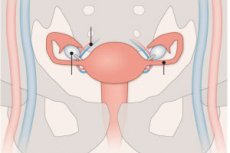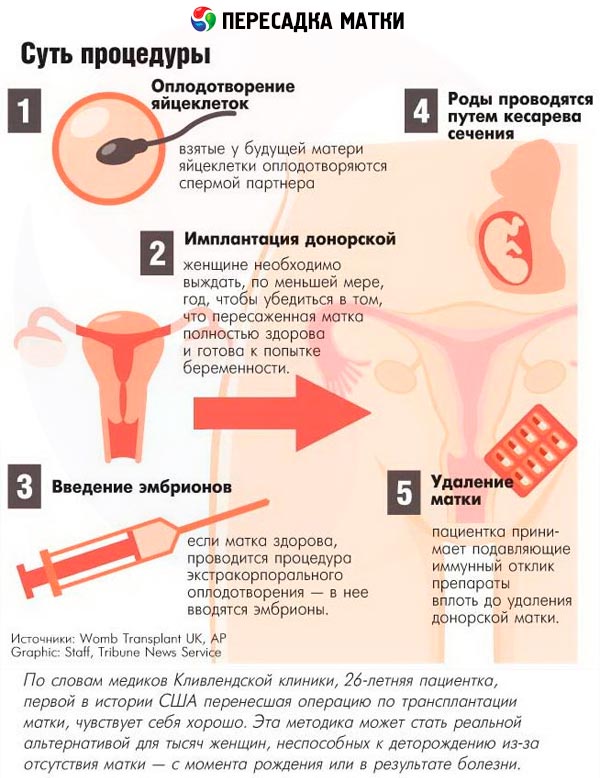Medical expert of the article
New publications
Uterine transplantation
Last reviewed: 06.07.2025

All iLive content is medically reviewed or fact checked to ensure as much factual accuracy as possible.
We have strict sourcing guidelines and only link to reputable media sites, academic research institutions and, whenever possible, medically peer reviewed studies. Note that the numbers in parentheses ([1], [2], etc.) are clickable links to these studies.
If you feel that any of our content is inaccurate, out-of-date, or otherwise questionable, please select it and press Ctrl + Enter.

Transplantation of most vital human organs no longer surprises anyone. These operations have been practically put on stream already in the last century. Uterine transplantation has not attracted close attention from doctors for a long time. After all, it is quite possible to live without this organ - a woman does not lose her ability to work, remains active in all spheres of life.
Congenital aplasia (agenesis) of the uterus is often discovered only in adolescence, when a girl is examined by a gynecologist due to the absence of menstruation. Sometimes a very young woman is forced to agree to a hysterectomy due to an oncological disease of the reproductive organs or as a result of other pathologies and injuries in order to save her life and live on. However, until recently, the absence of the main reproductive organ completely deprived her of the opportunity to become a mother.
Uterine transplantation will give women such a chance in the near future. Currently, this operation is in the experimental stage in many countries of the world. There are already impressive results - to date, babies have been carried to term and successfully born in transplanted uteruses.
Swedish medical scientists are ahead of the rest of the world. Of the nine uterus transplant operations performed in Gothenburg, seven were successful. Several babies have been born this way to date. The latest was recently born in the USA.
Indications for the procedure
The organ is transplanted to women of childbearing age who lack it, for the purpose of further pregnancy, bearing and giving birth to a child.
The reason for the absence of the uterus can be either congenital or acquired.
The recipient woman must be healthy enough to successfully undergo the surgery and subsequently become pregnant and give birth to a healthy baby.
The experiments conducted to date have involved young women diagnosed with absolute infertility due to the absence of a uterus, who are married to men capable of fertilization.
Preparation
The main stage of preparation for transplantation is the selection of an immunologically suitable donor. Preference is given to the patient's relatives, since in this case the donor organ has good hysterocompatibility with the recipient's body, and the risk of rejection is significantly reduced. In all cases, Swedish doctors used organs from close relatives, and the age of the donor was not important. This can be a woman who has reached menopause. The main selection criterion is a healthy uterus. In five Swedish recipients, the donors were their mothers, in four - close relatives.
A woman successfully operated on in Turkey received an organ transplant taken from a dead body. The patient eventually even managed to get pregnant, but due to complications the pregnancy was terminated.
In preparation for the experiment, both spouses undergo a special course of in vitro fertilization in order to preserve the embryos until the moment when, according to specialists, the uterus is ready for pregnancy.
Preparation or so-called conditioning of the recipient consists of suppressing her immunity in order to prevent rejection of the donor organ and allow it to take root.
Technique uterine transplants
The operation to transplant the uterus presents certain difficulties: firstly, the organ is located in a rather hard-to-reach place; secondly, it is surrounded by many small blood vessels; thirdly, the goal of the transplant is the pregnancy of the recipient and the birth of a healthy child, that is, the organ must not only take root and function, but also work in extreme conditions.
The technique for performing uterine transplantation was tested and honed through repeated transplantations in laboratory animals with subsequent births of healthy offspring.
Before the operation, each recipient had their own eggs taken, fertilized with the spouses’ sperm and stored for subsequent IVF.
The women could not get pregnant on their own, since the fallopian tubes are not yet attached to the uterus. All the women also gave birth by Caesarean section. However, science does not stand still, and scientists are already thinking about the possibility of not only natural childbirth, but also conception. To do this, it is necessary to transplant the entire complex of reproductive organs, and research in this direction is already being conducted.
Scientists are already talking about the fact that uterine transplantation to men is not far off. Transgender women also want to experience the joy of motherhood, and gays and single men are expected to take the initiative. However, for now, such possibilities are only being discussed from the point of view of ethics and the legislative framework. Nevertheless, scientists predict that uterine transplantation to men will become a reality in the next decade.

Contraindications to the procedure
Allotransplantations from incompatible donors are absolutely unacceptable if the recipient has malignant diseases of organs other than the one to be transplanted; drug-resistant infectious processes, tuberculosis, HIV infection, mental pathologies that prevent understanding the essence of the process and strictly following the doctor's recommendations.
Currently, the operations are performed on young married women who want to have children. While the operations are being carried out as part of an experiment, the social, gender and age categories of patients are not clearly defined.
After radical treatment of oncopathology of the reproductive organs, which results in the absence of the uterus in the patient, one to two years must pass.
Relative contraindications are individual characteristics of the patient’s health, which obviously complicate the technical aspects of the transplant.
Consequences after the procedure
The need to take lifelong immune-suppressing drugs to prevent transplant rejection is the most significant consequence of any organ transplant surgery.
Therefore, the uterus is not transplanted permanently, but temporarily. It is designed for a maximum of two pregnancies. Then it is removed to relieve the patient who has already become a mother from the need to constantly suppress her immunity and expose the body to the risk of all sorts of infections. Information has appeared that the first woman who gave birth to a child through a uterus transplant decided not to tempt fate any more and got rid of the foreign organ.
In vitro fertilization and Caesarean section birth are still the only way to experience the joy of motherhood. However, what woman who wants to become a mother can be stopped by such "trifles".
Complications after the procedure
Uterine transplants, especially from deceased donors, were complicated by the development of thrombosis and infections, leading to termination of pregnancy between the sixth and eighth week and removal of the transplanted organ.
The most successful surgeries were those involving living donors. The need for regular immunosuppressant use is thought to be associated with the risk of a severe pregnancy complication, preeclampsia, although a direct link has not yet been established.
Care after the procedure
Uterine transplantation is a purely abdominal operation and, accordingly, patients require standard care following such a procedure - bed rest, pain relief and intoxication after anesthesia, prevention of infectious complications, bleeding and blood clots, and other symptomatic treatment.
The main goal is to prevent rejection of the transplanted organ by prescribing the optimal dose of immunosuppressants.
The woman is constantly under the supervision of medical personnel in connection with the upcoming pregnancy and childbirth.


 [
[